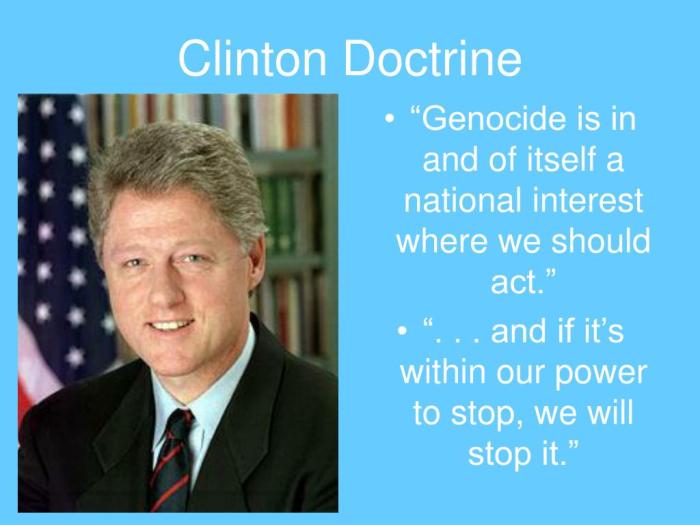
The Clinton Doctrine: Humanitarian Interventions and US Foreign Policy
The Clinton Doctrine of humanitarian interventions, a cornerstone of US foreign policy in the 1990s, marked a shift in the country’s approach to international affairs. This doctrine, shaped by historical events and evolving global realities, aimed to justify and guide US involvement in conflicts where human rights were at stake.
The Clinton administration’s commitment to promoting democracy and human rights abroad, coupled with the increasing awareness of global interconnectedness, propelled the development of this doctrine.
The Clinton Doctrine sought to establish a framework for humanitarian interventions, outlining principles and criteria for determining the legitimacy of US involvement in conflicts. This framework encompassed the promotion of human rights, the safeguarding of democratic values, and the adherence to international law.
However, the doctrine also sparked significant debate and controversy, with critics questioning its effectiveness, ethical implications, and potential for unintended consequences.
Origins and Context of the Clinton Doctrine
The Clinton Doctrine, a foreign policy approach adopted during the presidency of Bill Clinton, marked a shift in the United States’ approach to humanitarian interventions. This doctrine emerged in the context of a changing world order, following the end of the Cold War, and was shaped by a number of key events and factors.
The Clinton Doctrine of humanitarian interventions, while often touted as a force for good, has raised concerns about the potential for overreach and unintended consequences. The question of who benefits from these interventions, and whether they truly serve the interests of the people they’re meant to help, is further complicated by the growing trend of corporate takeover of US intelligence.
This raises the possibility that private interests could influence the decision-making process, potentially skewing interventions towards goals that align with corporate interests rather than genuine humanitarian concerns.
Historical Context and Influencing Events
The Clinton Doctrine emerged against the backdrop of the Cold War’s end, which led to a period of relative peace and stability. However, new challenges emerged, including ethnic conflicts, humanitarian crises, and the rise of terrorism. The 1990s witnessed a surge in humanitarian interventions, with the United States playing a prominent role in many of them.
These interventions, often undertaken without a clear mandate from the United Nations Security Council, raised questions about the limits of U.S. power and the role of humanitarian intervention in international affairs.
- The Rwandan genocide of 1994 was a pivotal event in shaping the Clinton Doctrine. The U.S. government’s inaction in the face of the genocide sparked widespread criticism and calls for a more proactive approach to humanitarian crises. The failure to intervene in Rwanda highlighted the potential consequences of inaction and the need for a more robust response to humanitarian emergencies.
- The Bosnian War (1992-1995) also significantly influenced the Clinton Doctrine. The U.S. involvement in the conflict, initially hesitant and limited, evolved into a more active role, culminating in the Dayton Accords, which brought an end to the war. The Bosnian intervention demonstrated the potential for the U.S.
to play a constructive role in resolving conflicts and promoting peace.
- The Kosovo War (1998-1999) marked a further evolution in U.S. policy. The Clinton administration, faced with the humanitarian crisis in Kosovo, launched a NATO-led air campaign against Serbia, ultimately leading to the withdrawal of Serbian forces from Kosovo. The Kosovo intervention solidified the idea that the U.S.
The Clinton Doctrine of humanitarian interventions, while well-intentioned, often faced criticism for its lack of clear criteria and potential for unintended consequences. This debate was reignited when the Bush administration’s “war on terror” faced a major setback in Spain, as seen in the article bush terror war suffers body blow in spain.
The Spanish public, deeply affected by the Madrid train bombings, turned against the war in Iraq, highlighting the complex relationship between international interventions and domestic political realities.
had a responsibility to intervene in humanitarian crises, even without a clear mandate from the UN Security Council.
Previous U.S. Interventions
The Clinton Doctrine drew inspiration from earlier U.S. interventions, which had established precedents for the use of military force in humanitarian contexts.
- The Vietnam War, though ultimately a failure, demonstrated the potential for the U.S. to become entangled in protracted and costly conflicts. The Vietnam War experience served as a cautionary tale, highlighting the need for clear objectives and a realistic assessment of the risks involved in humanitarian interventions.
- The Persian Gulf War (1991) provided a successful example of U.S. military intervention to address a humanitarian crisis. The U.S.-led coalition’s liberation of Kuwait from Iraqi occupation demonstrated the effectiveness of U.S. military power in achieving specific objectives and preventing humanitarian disasters.
- The Somalia intervention (1992-1993) provided a mixed experience. While initially successful in providing humanitarian assistance, the U.S. mission in Somalia became increasingly complex and ultimately ended in failure. The Somalia experience highlighted the challenges of peacekeeping and the need for careful planning and a clear exit strategy in humanitarian interventions.
The Clinton Doctrine, with its emphasis on humanitarian interventions, found itself entangled in the complex web of the Middle East conflict. Understanding the historical context of this conflict, the middle east conflict a brief background , is crucial for grasping the challenges faced by the Clinton administration in navigating this volatile region.
The doctrine’s application in the Middle East, while driven by noble intentions, often faced criticism for its unintended consequences, highlighting the complexities of international intervention in a region marked by deep-seated historical grievances.
Key Principles of the Clinton Doctrine

The Clinton Doctrine, which emerged during President Bill Clinton’s tenure, marked a shift in American foreign policy, emphasizing humanitarian intervention and the promotion of democracy and human rights. It defined a new approach to international affairs, moving beyond the Cold War era’s focus on containment and power politics.
Role of Human Rights, Democracy Promotion, and International Law, The clinton doctrine of humanitarian interventions
The Clinton Doctrine prioritized the protection of human rights and the promotion of democracy as core elements of American foreign policy. It argued that the United States had a moral obligation to intervene in situations where gross human rights violations were occurring, even if it did not directly threaten American national security.
This principle was rooted in the belief that democracy and human rights are universal values that should be upheld globally. The doctrine also emphasized the importance of adhering to international law, arguing that interventions should be conducted within the framework of international legal norms and principles.
Justifications and Criteria for Intervention
The Clinton Doctrine Artikeld several justifications for humanitarian intervention, including:
- Preventing genocide and other mass atrocities
- Responding to humanitarian crises
- Promoting democracy and human rights
The doctrine also established criteria for determining the legitimacy of interventions, which included:
- The severity of the humanitarian crisis or human rights violation
- The likelihood of success in achieving the intervention’s objectives
- The availability of international support for the intervention
- The potential risks and costs of intervention
The Clinton Doctrine aimed to strike a balance between the moral imperative to intervene in humanitarian crises and the practical considerations of international law, national security, and the potential risks of intervention.
Application of the Clinton Doctrine

The Clinton Doctrine, a foreign policy approach emphasizing humanitarian intervention, saw its application in several instances during the 1990s. While the doctrine aimed to promote human rights and democracy, its implementation was marked by both successes and failures, raising crucial ethical and political questions.
Key Instances of the Clinton Doctrine’s Application
The Clinton Doctrine’s application is best understood through examining specific interventions. These interventions highlight the doctrine’s strengths and weaknesses, showcasing its potential to address humanitarian crises while also revealing its limitations.
- The 1999 Kosovo War: This intervention, undertaken by NATO forces without UN Security Council authorization, aimed to stop the ethnic cleansing of Albanian Kosovars by Serbian forces. Despite initial opposition from Russia and China, the intervention ultimately succeeded in halting the violence and establishing a UN protectorate in Kosovo.
This intervention exemplified the doctrine’s willingness to act decisively in the face of egregious human rights violations, even without explicit UN approval.
- The 1991 Gulf War: While not explicitly defined as a humanitarian intervention, the first Gulf War, launched by a US-led coalition to liberate Kuwait from Iraqi occupation, demonstrated the Clinton administration’s willingness to use military force to address regional conflicts.
This intervention, though primarily focused on protecting Kuwait’s sovereignty, also aimed to prevent Saddam Hussein’s regime from expanding its influence in the region, indirectly contributing to the protection of civilians.
- The 1993 Somali Intervention: The intervention in Somalia, aimed at delivering humanitarian aid and restoring order, ultimately ended in failure. The US withdrew its forces after a Black Hawk helicopter was shot down, leading to the deaths of 18 American soldiers.
This intervention highlighted the complexities of humanitarian interventions, particularly the challenges of maintaining a stable environment and preventing unintended consequences.
- The 1994 Rwandan Genocide: The Clinton administration’s failure to intervene during the Rwandan genocide remains a controversial aspect of its foreign policy. Despite warnings of impending violence, the US chose not to deploy troops, arguing that the situation was too complex and that there was no clear strategy for intervention.
This inaction, widely criticized for its lack of decisiveness, exposed the limitations of the Clinton Doctrine in situations where intervention was deemed too risky or politically infeasible.
Impact and Legacy of the Clinton Doctrine: The Clinton Doctrine Of Humanitarian Interventions

The Clinton Doctrine, with its emphasis on humanitarian intervention, has left a lasting mark on U.S. foreign policy. While its application has been inconsistent and subject to debate, it has undeniably shaped the way the United States approaches international crises and the use of military force.
Long-Term Impact on U.S. Foreign Policy
The Clinton Doctrine’s most significant impact lies in its normalization of humanitarian intervention as a legitimate tool of U.S. foreign policy. Prior to the Clinton administration, such interventions were generally viewed with skepticism, often seen as risky and potentially counterproductive.
The Clinton administration’s willingness to intervene in Somalia, Haiti, and the Balkans, however, helped to legitimize the idea of using military force to address humanitarian crises. This shift in thinking has had a lasting impact on U.S. foreign policy, leading to subsequent interventions in Kosovo, Libya, and Syria, among others.
Embracing and Rejecting the Doctrine
The Clinton Doctrine has been embraced and rejected in varying degrees by subsequent administrations. The George W. Bush administration, for instance, built upon the doctrine’s principles in its “war on terror,” arguing that the United States had a responsibility to intervene in conflicts that threatened global security.
The Obama administration, while initially hesitant to embrace the doctrine, ultimately authorized interventions in Libya and Syria, albeit with significant caveats. The Trump administration, on the other hand, largely rejected the Clinton Doctrine, prioritizing a more “America First” approach to foreign policy and limiting the use of military force.
Criticisms and Controversies
The Clinton Doctrine has been subject to significant criticism and controversy. Critics argue that it represents an overreach of U.S. power and a violation of national sovereignty. They point to the unintended consequences of U.S. interventions, such as the destabilization of countries and the creation of humanitarian crises.
Others argue that the doctrine is selective in its application, often being invoked in situations where U.S. interests align with humanitarian concerns but not in other cases.
Contemporary Relevance of the Clinton Doctrine
The Clinton Doctrine, with its emphasis on humanitarian intervention, remains a significant point of discussion in the 21st century. While its application has been debated, its underlying principles continue to influence international relations and the global security landscape.
The Enduring Relevance of Humanitarian Intervention
The need for humanitarian intervention in situations of mass atrocities, genocide, and gross human rights violations continues to be a pressing issue. The international community faces a complex web of challenges, including armed conflicts, state fragility, and the rise of transnational threats.
These challenges often manifest in humanitarian crises, highlighting the importance of a framework for responding to such situations.
Ongoing Debates on the Role of Humanitarian Intervention
The Clinton Doctrine has sparked ongoing debates about the role of humanitarian intervention in the 21st century. Some argue that intervention is necessary to prevent atrocities and protect civilians, while others express concerns about the potential for unintended consequences, including exacerbating conflict and undermining state sovereignty.
Key Considerations in the Debate:
- Legitimacy and Authorization:The debate often centers on the legitimacy and authorization of humanitarian interventions. While the UN Charter provides a framework for collective security, the legal basis for unilateral interventions remains contentious.
- Effectiveness and Responsibility:Another key concern is the effectiveness and responsibility of humanitarian interventions. Critics argue that interventions can be counterproductive, leading to prolonged conflicts and exacerbating humanitarian crises.
- National Interests and International Cooperation:The role of national interests in humanitarian intervention is also a point of debate. Critics argue that interventions are often driven by self-interest rather than genuine humanitarian concerns.






